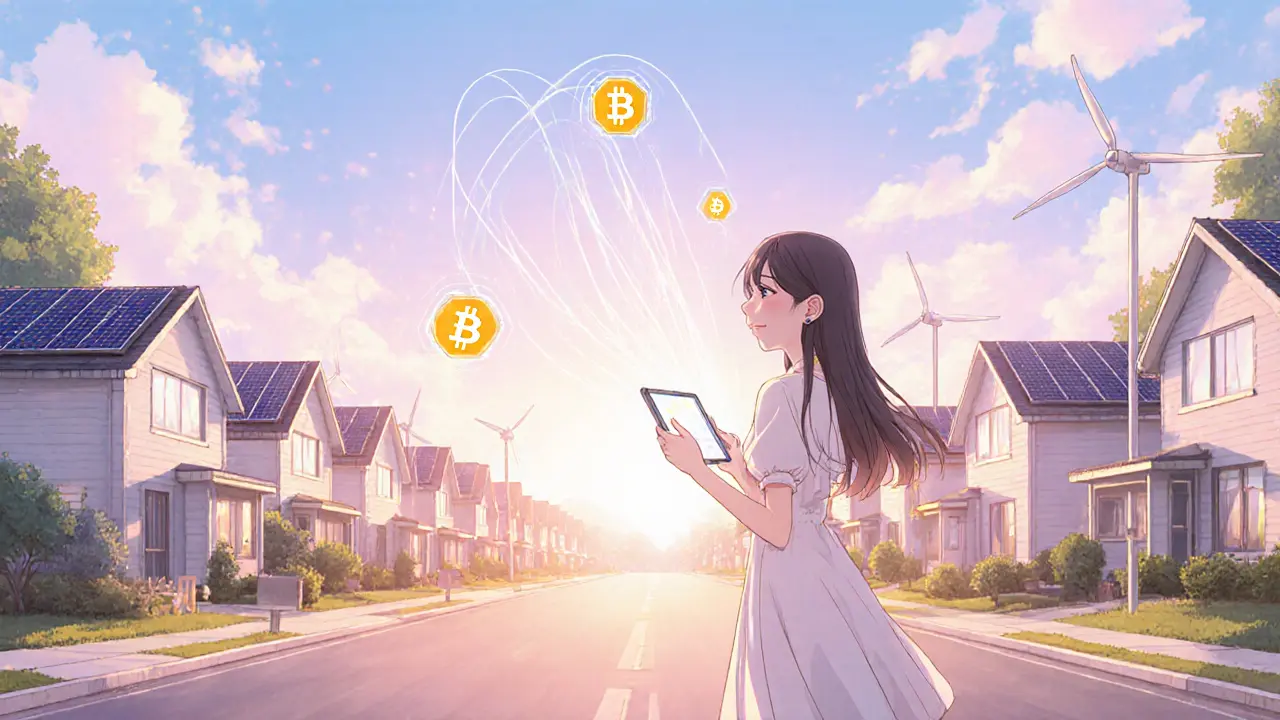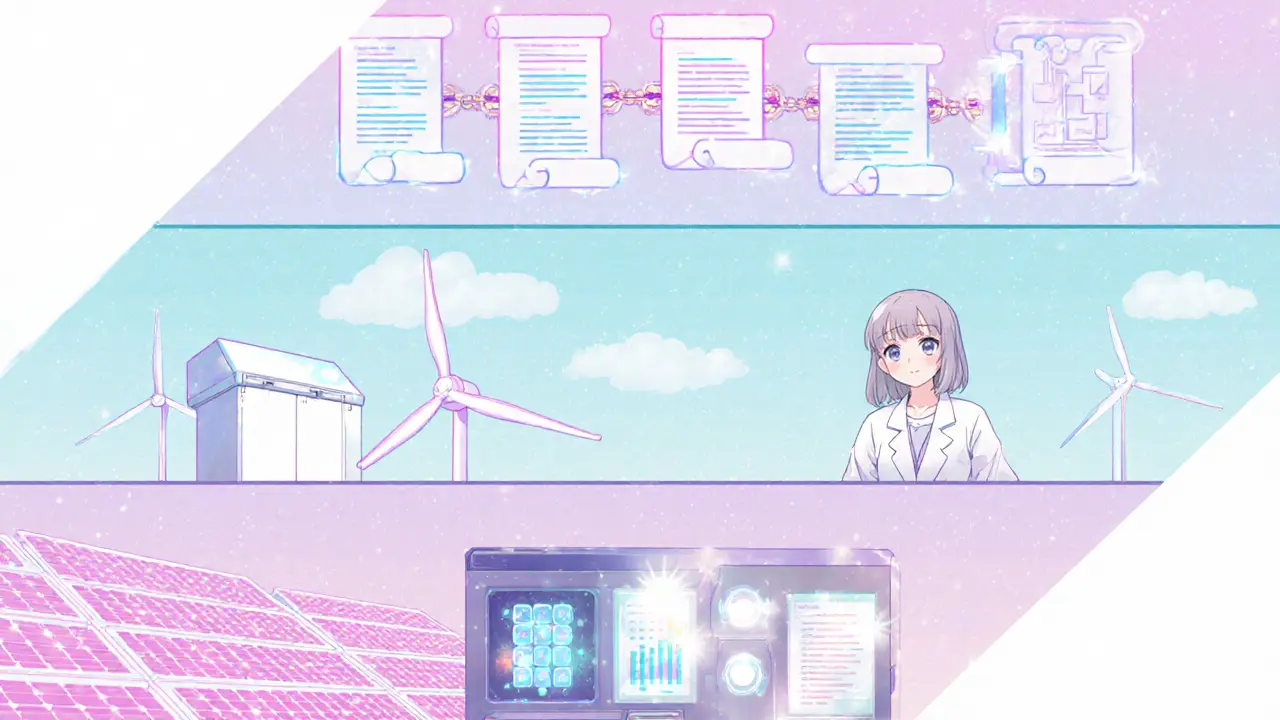How Blockchain Transforms Microgrids: Peer-to-Peer Energy Trading Explained

Blockchain Energy Trading Calculator
Estimate Your Energy Earnings
Calculate potential revenue from selling excess solar energy to neighbors in a blockchain-powered microgrid
Estimated Earnings
Based on your microgrid participation and blockchain settlement system
Imagine a neighbourhood where households not only consume electricity but also sell excess solar power directly to neighbours, without a utility bill going through a massive central office. That vision becomes real when Microgrid is paired with Blockchain. The combo replaces slow, opaque paperwork with instant, tamper‑proof ledgers, turning energy from a commodity into a local marketplace.
What is a microgrid?
A microgrid is a self‑contained energy network that can run on its own or stay hooked to the main grid. It usually bundles solar panels, wind turbines, battery packs, and sometimes a diesel generator. Advanced controllers balance supply and demand in real time, while the whole system can island during outages, keeping lights on for critical loads.
Why blockchain matters for energy
Blockchain is a type of distributed ledger technology (DLT) that records transactions in a chain of blocks, each secured by cryptographic hashes. Its key traits-decentralization, immutability, and programmable smart contracts-solve three pain points in traditional energy trading: lack of transparency, reliance on a central clearinghouse, and slow settlement.
Technical architecture of a blockchain‑enabled microgrid
When the two systems meet, the architecture looks like this:
- Physical layer: Distributed Energy Resources (DERs) such as solar PV, wind, and battery storage.
- Control layer: Energy Management System (EMS) that schedules generation, storage, and loads.
- Ledger layer: Permissioned or public blockchain that logs every kWh exchanged.
- Smart‑contract layer: Self‑executing contracts that automatically settle trades, verify Renewable Energy Certificates (RECs), and enforce demand‑response signals.
The EMS writes a signed transaction to the ledger each time a prosumer sells 1 kWh to a neighbor. The smart contract validates the price, updates balances, and triggers the physical flow through inverters. No human needs to approve the trade.
Benefits over traditional grid models
Below is a side‑by‑side look at how a conventional grid stacks up against a blockchain‑powered microgrid.
| Aspect | Traditional Grid | Blockchain Microgrid |
|---|---|---|
| Control | Centralized utilities | Decentralized peer‑to‑peer |
| Transaction Transparency | Limited, paper‑based settlements | Fully visible on immutable ledger |
| Settlement Time | Days to weeks | Seconds to minutes |
| Security of Data | Vulnerable to central breaches | Cryptographic protection |
| Market Participation | Utility‑only | Prosumers, community groups, EV owners |

Real‑world use cases
1. Peer‑to‑peer energy trading: Households sell surplus solar directly to neighbours via a blockchain marketplace, setting prices in real time.
2. Renewable Energy Certificates: Each generated MWh is tokenized, giving owners a traceable REC that can be traded or retired for compliance.
3. Green hydrogen supply chain: Blockchain tracks hydrogen production, storage, and transport, ensuring the fuel’s origin remains green.
4. Demand‑response incentives: Smart contracts reward users who shift load during peak hours, automatically crediting their wallets.
Implementation considerations
Getting a blockchain microgrid off the ground requires attention to several technical details:
- Interconnection standards: Hybrid AC/DC configurations must obey IEC 61850‑like protocols to avoid instability when toggling between islanded and grid‑connected modes.
- Energy storage sizing: Batteries buffer the latency between physical power flow and ledger confirmation, keeping voltage within limits.
- Smart‑contract design: Contracts should include dispute‑resolution clauses and fallback mechanisms for communication loss.
- Multi‑agent trading frameworks: Agents representing generators, storage, and loads negotiate prices, reducing the need for a single market operator.
- Cybersecurity: Combining blockchain with machine‑learning anomaly detection helps spot rogue injections before they affect the grid.
Challenges that still need work
Even with its promise, the technology faces hurdles:
- Transient stability: Rapid switching between control modes can cause voltage spikes if not coordinated.
- Scalability: Public blockchains struggle with high transaction throughput; permissioned ledgers often offset this with centralized governance.
- Regulatory uncertainty: Many jurisdictions still lack clear rules for peer‑to‑peer energy markets.
- Interoperability: Different vendors use diverse communication stacks, making seamless integration tricky.

Future outlook - the emerging "energy internet"
Researchers envision an "energy internet" where every device-from rooftop panels to electric‑vehicle chargers-talks to each other using standardized blockchain protocols. Such a network would enable:
- Global peer‑to‑peer energy exchanges across borders.
- Real‑time carbon‑footprint accounting for every kilowatt‑hour.
- Automated micro‑transactions that fund community upgrades, like new battery farms.
Commercial pilots in Australia, Germany, and the United States are already testing these concepts, and early results show up to 30 % reduction in settlement costs compared with legacy systems.
Quick checklist for getting started
- Define the scope: community size, DER mix, and target market (P2P trade, REC issuance, etc.).
- Select a blockchain platform (e.g., Hyperledger Fabric for permissioned, Ethereum for public).
- Develop smart contracts that handle pricing, settlement, and compliance.
- Integrate EMS with blockchain APIs using IEC 61850 or Modbus adapters.
- Run a pilot with a handful of prosumers before scaling.
Conclusion
Blockchain doesn’t magically create energy, but it does give communities a trustworthy, automated way to share what they already generate. By marrying microgrids with distributed ledgers, we get faster settlements, clear audit trails, and a market that truly belongs to the people who produce the power. The road ahead still has technical and regulatory bumps, yet the momentum is undeniable-especially as the world pushes for greener, more resilient grids.
Can a regular household join a blockchain microgrid?
Yes. If the house has a renewable source (solar panels, wind turbine) and a smart inverter that can communicate with the ledger, it can act as a prosumer-selling excess energy and buying when needed.
What’s the difference between a public and a permissioned blockchain for energy?
Public chains like Ethereum let anyone read or write transactions, offering maximal transparency but lower throughput. Permissioned chains (e.g., Hyperledger Fabric) restrict participation to known nodes, boosting speed and privacy-often a better fit for regulated energy markets.
How do smart contracts settle an energy trade?
When a buyer submits a request for 5 kWh, the contract checks the seller’s available balance, locks the amount, and upon confirmation of physical delivery (via meter data) releases the tokens to the seller’s digital wallet.
Is blockchain energy‑intensive for microgrid applications?
Permissioned or lightweight consensus mechanisms (e.g., Practical Byzantine Fault Tolerance) consume far less power than Bitcoin‑style proof‑of‑work, making them suitable for microgrid environments.
What regulatory hurdles should I expect?
Regulators may require reporting of all trades, compliance with local electricity licensing, and consumer‑protection rules. Engaging with the utility early can smooth approvals.
Tom Glynn
😊 Imagine a world where your rooftop sun becomes a tiny bank for the whole block. We’re not talking sci‑fi, we’re talking real micro‑grids that talk to each other on a blockchain ledger. It’s like giving every house a piece of the pie and letting them trade slices instantly. The beauty lies in the trust‑less design – no middle‑man, just code and sunshine. 🌞💡
Johanna Hegewald
Microgrids let neighborhoods generate and share power locally, and blockchain records each kWh trade transparently. This cuts down paperwork and speeds up settlements. Think of it as a digital ledger for electricity.
Benjamin Debrick
One must, almost inevitably, discern the epistemological ramifications of integrating distributed ledger technology with autonomous energy islands, for such a synthesis transcends mere operational efficiency; it heralds a paradigmatic shift in the ontology of energy commerce-indeed, a decentralised agora where every kilowatt‑hour assumes both commodity and covenant. Moreover, the immutability of the chain obviates the need for regulatory oversight, thereby democratizing access in a manner hitherto unimaginable.